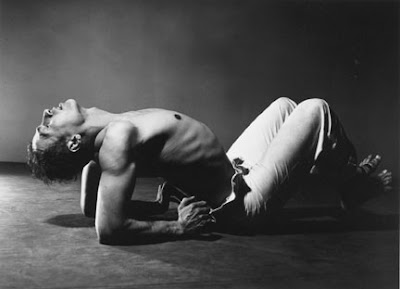Born in Kansas in 1900, Barbara Morgan
moved with her family to a peach farm in Southern California where she spent
her youth. During this time, Morgan developed an early interest in dance
and movement. Her father noted this interest and suggested that the five-year-old
“think of everything in the world as dancing atoms.”[1]
Since that young age, Morgan examined the world and her artwork with this
scientific perspective.
This mindset was further affirmed during Morgan’s
formal training at the University of California Los Angeles (UCLA) in 1923. Under
the direction and principles of Arthur Wesley Dow, Morgan explored the concept
of art synthesis, which paired abstract design with figurative drawing and
painting.[2]
These principles are evident in Morgan’s early work, which consisted mostly of
drawings, prints, and watercolors. She was
also influenced by the “Chinese Six Canons of Painting,” which were developed
by art historian, Xie He, in sixth-century China. According to He, there were six points to
consider when examining a painting: spirit resonance, bone method,
correspondence to the object, suitability to type, division and planning, and
transmission by copying.[3]
Morgan specifically appreciated the concept of spirit resonance, which refers
to the vitality and nervous energy transmitted from the artist into the work. This
energy contributes to the overall power of a work of art. He contested that
without spirit resonance, there was no need to look further into an artwork.
Morgan felt similarly and found that spirit resonance encapsulated her father’s
early suggestion on how the world and beauty was composed.
Morgan found that she could incorporate
spirit resonance into her work through lighting and balance. While at UCLA,
Morgan volunteered to set up stage lighting for a group of visiting French
playwrights. The playwrights staged and performed Failures, a play that traced emotional changes over time. Morgan
was tasked with constantly changing the mood on stage through the lighting. Since
Morgan possessed no training in theatre or lighting, much of her learning
occurred on site. Despite this lack of knowledge, Morgan became fascinated by
lighting principles and was able to master them in a short time. The experience
taught her about the overall power and role lighting plays in bestowing meaning
to an artwork.
Morgan experienced a shift in her career
after working with her husband, Willard D. Morgan, on a photo project of Dr.
Albert Barnes’ art collection in Merion, Pennsylvania. At the time, Morgan did
not consider herself a photographer; however, she used the project to explore
photographic lighting. As part of the project, Morgan was allowed to photograph
Barnes’ entire collection. While photographing a fertility sculpture from Sudan
and masks from the Ivory Coast, she discovered how these ritual sculptures
became either menacing or benign, through control of lighting.[4]
This revelation further confirmed Morgan’s belief in the power of lighting and
shifted her interests to photography. In fact, light manipulation became the
central theme in her famous photographs of American modern dance and movement.
In Morgan’s photographs of dance and
dancers, she attempted to free figures within space, focusing on singular
movements and light in order to create a slow-motion effect. Morgan stated, “I
love to build a lighting scheme in which light and the moving subject matter is
reciprocally alive; now moving in opposition, by-passing, flowing together,
modulating into shadow, reappearing in muted areas, until the entire design is
rich and mobile.”[5] Morgan’s
passion for lighting schemes is prominent in her Sixteen Dances series. For this series, she collaborated with
Martha Graham, a modern dancer and choreographer, and her company.
 |
| Barbara Morgan, Jose Limon-Mexican Suite-Peon-1944, 1944, printed c. 1980, silver print. Gift of Gary Granoff, Esq., 1983. |
Sixteen
Dances is an important
series in Morgan’s career because it showcases the purpose and artistry behind
her craft. Morgan shot all of the photographs in Sixteen Dances in her studio with specific lighting that she
designed for each piece. Thus, the project was challenging from a technical
point of view and put insurmountable pressure on Graham and her company. Due to
the technicality of Morgan’s process, Graham and her dancers were often asked
to pose and re-pose countless times in order to achieve the proper lighting and
perspective. Reflecting on the experience, Graham remarked in an interview
that, “[Morgan] was a terror.”[6]
However, it is important to note that Morgan’s specificity during the project
was necessary in order to transfuse spirit resonance into each piece. Morgan
remarked on this necessity, stating, “I wanted to show that Martha had her own
vision. That what she was conveying was deeper than ego, deeper than baloney.
Dance has to go beyond theater....I was trying to connect her spirit with the
viewer—to show pictures of spiritual energy.”[7]
Ultimately, in the series, Graham’s energy is successfully conveyed as a fluid
and significant movement, which the viewer can experience without having knowledge
of the entire dance.
Capturing the beauty and effort of dance
on film takes not only a trained eye, but, more importantly, an understanding
of the science that creates such action. Barbara Morgan mastered both of these
abilities. Her legacy of observing life in relation to “dancing atoms” will always
be preserved on film and on paper, providing a glimpse into her world of
photography, light and modern dance.
Barbara Morgan’s works will be on display
as a part of The Other 90%: Works
from the GW Permanent Collection, on view until June 3, 2016 at
the Luther W. Brady Art Gallery.
[1] Dunning,
J. (1992, August 19). Barbara Morgan, Photographer Of Modern Dance, Is Dead at
92. The New York Times. Retrieved from http://www.nytimes.com/1992/08/19/arts/
barbara-morgan-photographer-of-modern-dance-is-dead-at-92.html
[2] Knappe, B. (2008). Barbara
Morgan’s Photographic Interpretation of American Culture, 1935-1980.
[3] Cahill, J. F.. (1961). The Six Laws and How to
Read Them. Ars Orientalis, 4, 372–381. Retrieved from
http://www.jstor.org/stable/4629151
[4] Knappe, B. (2008). Barbara
Morgan’s Photographic Interpretation of American Culture, 1935-1980.
[5] Morgan, “Kinetic Design
in Photography,” 27.
[6] Acocella, J. (2011, June
1). An Unforgettable Photo of Martha Graham. Smithsonian Magazine.
